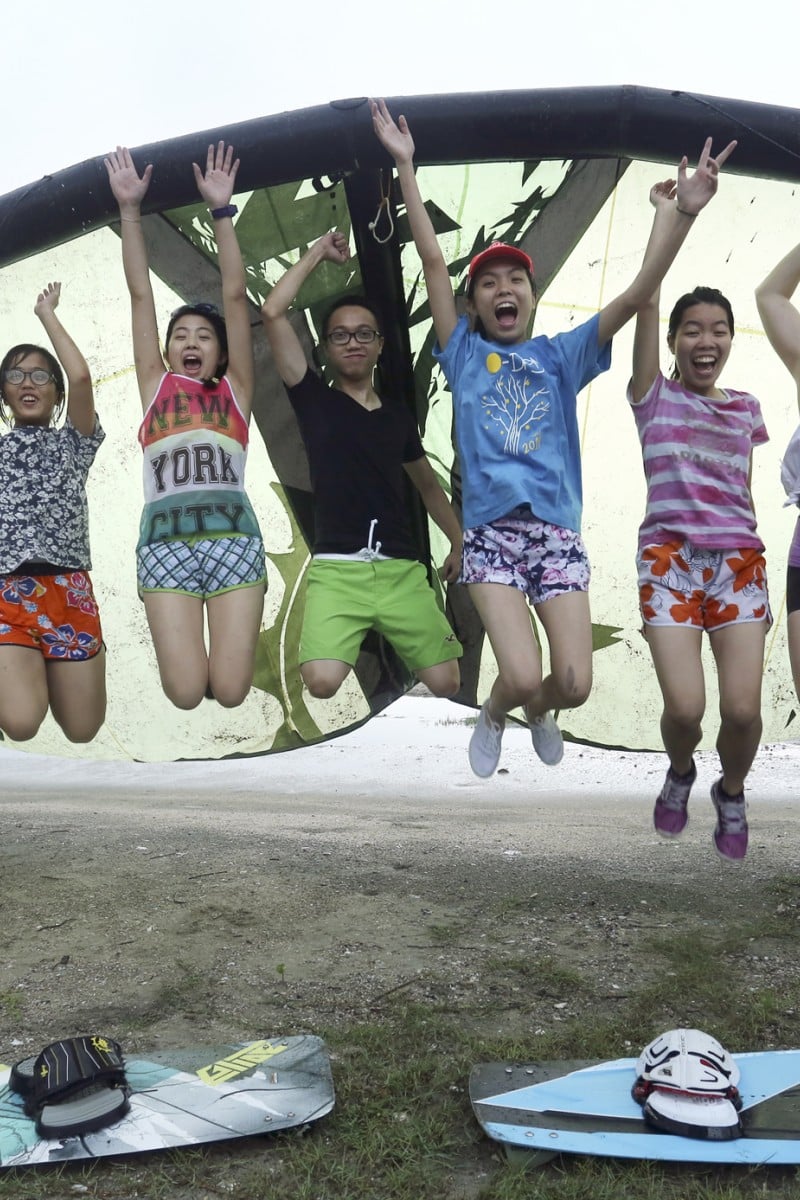 Junior reporters (from left) Phoebe Ho, Jessie Pang, Natasha Lau, Joseph Ho, Christy Cheung, Dorothy Yim, and reporter Ariel Conant look as high as kites on Shui Hau Wan beach
Junior reporters (from left) Phoebe Ho, Jessie Pang, Natasha Lau, Joseph Ho, Christy Cheung, Dorothy Yim, and reporter Ariel Conant look as high as kites on Shui Hau Wan beachOn a dark and stormy day, six Young Post junior reporters set out to Shui Ho Wan beach on Lantau to try and learn how to kiteboard. But with thunderstorms building, would they be able to get out on the water at all?
As the junior reporters arrived on the beach, they were greeted by Leung Hoi-tin, the lead instructor and founder of Hong Kong Kiteboarding School, along with assistant instructor Davy Tang. Everyone was eager to get right out into the water, but Leung and Tang explained that we first had to learn the basics.
Kiteboarding is a new sport in Hong Kong. None of the six junior reporters had ever tried it before.
To kiteboard, you need two important pieces of equipment: a board and a kite. But it's not as simple as it sounds. The board is specially designed so you can strap your feet into it. And the kite is big and layered so it catches the wind in the right way. Strings go down from the kite onto a handle, which is controlled like the handlebars of a bicycle. Pull the left side towards you, and you'll turn left.
While that might sound simple, it's actually difficult to get the hang of controlling the kite.
When holding the handle, it's natural to want to turn it more like the wheel of a car, spinning one side up or down, rather that pushing and pulling straight on. And when the kite is in the air, it's even trickier to control the speed.
But once you can control the kite, all you need is a good strong wind and the ocean. When you get good at kiteboarding, you can do amazing tricks that let you fly through the air, and skim over the top of the waves.
We weren't even close to doing any tricks yet, though. First we needed to learn how to control the kites.
Leung and Tang wanted us to try out the practice kites on land to help us get used to the feeling of controlling the wild kites. But first we needed wind to help make the kites fly.
Our two instructors explained that it was important to know which direction the wind was coming from, so we could aim the kites in the right direction to catch it. But as soon as a good breeze came through, so did the lightning.
Since the kites fly so high into the air, it's dangerous to fly them when there is lightning and thunder. We didn't want to turn into flash-fried reporters, so we took shelter and waited for the bad weather to pass.
After a while, the lightning stopped, and we were able to finally practise with the kites.
Junior reporter Joseph Ho Hei-chi, 19, a student at the University of Hong Kong, was surprised at how much strength he needed to control the kite, even just on land.
"It's a good idea to do some exercise to build up your strength," he recommends. "Or else you will be blown away by strong winds."
After some more practice on land, it was time to move out into the water. But that was also when the wind decided to move on as well. Without the wind we were dead in the water, as the kites wouldn't fly.
But it wasn't over for us. Instead, Leung and Tang brought out a stand-up paddle board for us to practise on. While a SUP is different from a kiteboard, it's still good to practise balancing in the water. Some of the junior reporters found it really hard to balance on the board, but others were able to stand up and paddle in the shallow water. It was a good lesson in stability and balance that would help our kiteboarding. Balance is useful for lots of other sports, too.
There wasn't enough wind on the water for us to get the kites up into the air, but we moved back to dry land and were able to find enough wind to keep playing with the practice kites.
For junior reporter Natasha Lau, 18, a graduate of South Island School, the whole day was worth it because she got to learn a new sport, even though she didn't get to try it in the water.
"We could still use the wind and have some fun," she said.
